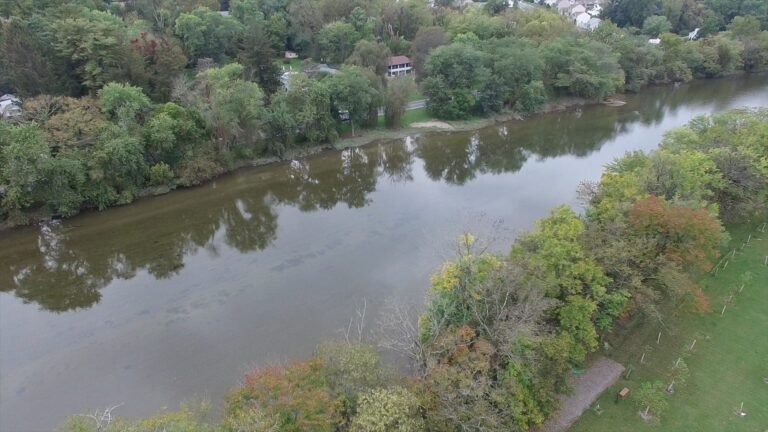[ad_1]
-
Rachel McDevitt

Doug Watson / WITF
This view of the Conodoguinet River outside Harrisburg shows the banks close to residential areas. Rains are predicted to fall more frequently and heavier due to climate change, and rising river levels could threaten nearby roads and homes.
A Cumberland County group is working to get more people involved in protecting our waterways.
Conodoguinet Creek flows about 100 miles through Franklin and Cumberland counties before joining the Susquehanna River near Harrisburg.
A project called “Creek Defenders,” led by a group called “Move Past Plastic,” is seeking volunteers to collect information about pollution along streams and their sources.
The group’s founder, Tamela Trussell, said the goal is to combine citizen science with existing data from regulators.
“The information is spread out in so many different places and it’s not really accessible to local residents, leaders or watershed organizations,” Trussell said.
Through this project, the group aims to teach people how to identify known and potential sources of pollution and to raise awareness about the impacts that chemical and physical pollution can have on the environment and health.
Those who want to take part can find out more information and fill out a contamination report on the Move Past Plastic website.
Trussell said contamination reports can be used to identify improper burning or dumping of trash, tires, electronics, bedding or building materials. People can also report small plastic blocks called nurdles, chemicals, dead fish, unusual colors or odors in the water, storm erosion or leaks from the petrochemical industry.
Trussell said the group will work with partners to investigate the reports and produce maps.
Trussell said the all-volunteer core team has been invaluable in making the project happen. The group works with one Community Science Fellow and three Community Scientists.
MPP developed the project proposal in collaboration with the Environmental Protection Network, a nonprofit organization where former Environmental Protection Agency officials provide their subject matter expertise. The project is funded by a grant from the American Geophysical Union’s Thriving Earth.
Exchange, aimed at supporting community science.
Elizabeth Sutherland retired in 2017 after 30 years with the EPA, including as director of science and technology for the agency’s Office of Water Resources.
She called the Creek Defenders project an excellent example of a watershed monitoring program.
The EPN frequently advises which pollutants should be monitored based on discharges and land use in each watershed, and what concentrations of those pollutants would be of concern, she said.
“EPN is well aware that state and federal governments lack the resources to investigate contamination in every location where problems are suspected, so we prioritize technical assistance to local communities,” Sutherland said.
The group plans to create an interactive map of the stream and its watershed to show where the health and environmental risks lie.
The group also plans to release a report by April 2025 with recommendations for restoring and protecting the stream.
Trussell hopes the initiative can serve as a model for other watersheds.
“The idea is for the whole community to come together and address pollution before it becomes part of the environment,” she said.
Many of Pennsylvania’s waterways are already under threat from pollution. More than 28,000 miles of the state’s rivers and streams, or 34 percent, are estimated to be polluted. The Environmental Protection Agency’s most recent water quality monitoring report cites agriculture, acid mine drainage, and urban runoff as major sources of pollution.
A U.S. Geological Survey report last year found that 76 percent of 161 Pennsylvania rivers and streams tested contained one or more PFAS, known as “forever chemicals.” The chemicals are widely used in products like waterproof clothing, nonstick cookware and firefighting foam. They take a very long time to break down in the environment and have been linked to health risks, including cancer.
Steve Hobozdovich of Clean Water Action said the Creek Defenders program is an example of the public participation that is the basis for effective government engagement and industry accountability.
“With DEP’s continuing underfunding, these types of projects are even more critical,” Hobozdovich said. “DEP Clean Water Program staff recently reported that they need at least 20 more river biologists, in addition to the 20 they currently have. Currently, the program only has the manpower to inspect a river once every 30 years. Inspections should occur about once every five years.”
Editor’s Pick
[ad_2]
Source link


